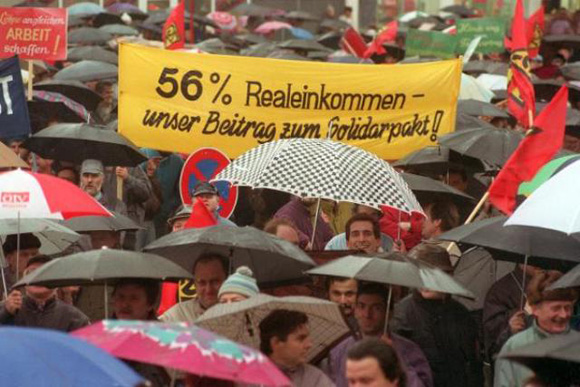













INTRODUCTION | DOCUMENTS | IMAGES | MAPS | EDITOR
|
To finance unification, the federal government [Bund] and the federal states [Länder] first set up a “German Unity Fund,” which was initially endowed with 115 billion Deutschmarks for the years 1990-94. Because this amount was insufficient, a solidarity surcharge of 3.75% of the income and corporation tax was levied in 1991 and 1992. Further negotiations between representatives of the federal government, the federal states, and the parties on the new regulation of finances eventually led to the proposal of a solidarity pact, which, among other things, envisaged the inclusion of the East German states in the State Fiscal Equalization Scheme as well as the reintroduction of the solidarity surcharge from 1995 on (at first, 7.5% of the income and corporation tax, later reduced to 5.5%). It was clear that the pact would have a disproportionately negative effect on people with lower incomes. On February 17, 1993, despite the pouring rain, about 10,000 workers in Chemnitz went out to protest the proposed solidarity pact. Instead of fiscal equalization, they demanded the maintenance of industrial centers in East Germany and the observance of the Saxon labor agreement. In the end, protests of this sort did not prevent representatives of the federal government, the minister presidents of the Länder, and party leaders from agreeing on the so-called Solidarity Pact I on March 16, 1993. The yellow sign reads: "56% of Real Income – Our Contribution to the Solidarity Pact." Photo: Thomas Lehmann.
picture-alliance / dpa
|
 print version
print version return to image list
return to image list previous image
previous image
